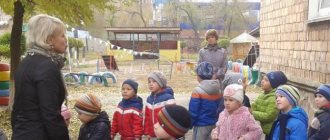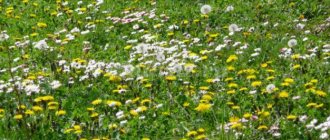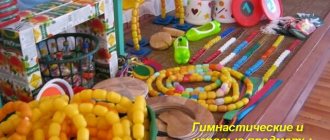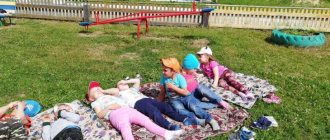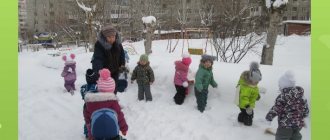Organization and methodology of walks in the summer
Author: Kravyakova Svetlana Vitalievna
Consultation for educators “Organization and methods of conducting walks in the summer”
Good afternoon, dear colleagues!
Today we are starting with you our seminar - a workshop on organizing and conducting walks in the summer.
I would like to start my speech with the statement of one pediatrician who said: “A day spent by a child without a walk is lost for his health” (G.N. Speransky)
So what is a walk?
A walk is a routine moment of children’s life activity in a preschool institution, organized in advance by the teacher, which takes place in the fresh air.
You all know well that the daily routine of any kindergarten includes a daily afternoon walk after classes and an evening walk after afternoon tea. According to
According to sanitary and epidemiological rules and regulations, the total duration of the walk is 4 - 4.5 hours.
In the summer, the kindergarten daily routine provides for children to spend maximum time in the fresh air with breaks for meals and sleep.
The time allotted for walking must be strictly observed.
But, in fact, children walk less, the duration of the walk is reduced for various reasons, and its health-improving and developmental potential is far from being fully used. Disorganization and monotony are typical disadvantages of organizing walks in kindergarten. And the pedagogical influence on a walk is often replaced by childcare.
Therefore, in order to properly organize and manage children’s activities during a walk, the teacher must expand his knowledge, possess practical skills, as well as methods for conducting a walk.
And first, let's remember what kind of walks there are.
Types of walks:
- Traditional/typical – the most free activity for children.
- Combined – targeted walk and free activity. (Targeted walk is carried out from the second younger group with exit outside the kindergarten);
- Excursion (conducted from the middle group at least once a month);
· Hiking (with children of senior preschool age).
Today at the seminar we will look in detail at the structure and methodology of conducting a traditional/or standard walk.
Proper organization of such a walk involves the use of five parts:
· Observation;
· Labor activity of children;
· Outdoor games
· Individual work with children;
· Independent activity of children.
The effectiveness of all parts of the walk depends entirely on the teacher. These components allow you to make your walk more eventful and interesting. In addition, they act not as separate pedagogical events, but as logically substantiated parts of what is planned by the teacher in a specific outing.
And now, let's take a closer look at each component of the walk.
Observations can be roughly divided into several types:
• Observations of wildlife (representatives of flora and fauna - plants, animals, birds, insects).
• Observations of inanimate nature (seasonal and weather phenomena, familiarity with the properties of water, sand, clay, natural materials - stones, shells, etc.).
• Observations of the work of adults (observations of the work of adults who work near the kindergarten are organized: janitor, driver, builder, policeman).
• Observations of street life (public, personal transport, trucks, cars, special vehicles, colorful decorations for the holidays).
At a younger age, observations should take no more than 5-10 minutes, at an older age they should range from 10 to 20 minutes. They must be carried out daily, and each time children should be offered different objects to consider.
It is very difficult to hold the attention of a child, especially one of primary preschool age. While walking, a child encounters a lot of distractions: he noticed a flying butterfly or was distracted by the noise of a passing car, and there are a lot of such distractions on the street. Therefore, observations should not be extended in time, vivid, interesting and meaningful. When planning observations, the teacher must think about: the equipment and materials that he will use during the observation, the placement of children, the teacher must think about ways to attract the attention of children (this could be: surprise moments, the use of artistic words: poetic texts, riddles, proverbs and sayings, which are perceived by children with great interest and other techniques), it is also necessary to involve the children themselves in activating mental activity (and this can be done by asking search questions and using children’s experience). The main thing in this component of the walk is not to leave children indifferent to the sight of vivid images and events in the environment.
The next important component of the walk is outdoor games.
. This part of the walk includes: 2-3 games of high mobility, 2-3 games of low and medium mobility, games of the children’s choice and didactic games are also used.
Outdoor games in the junior group - 6-10 minutes, in the middle group - 10-15 minutes, in the senior and preparatory groups - 20-25 minutes.
When choosing a game, the teacher should consider the following factors:
-time of year (weather conditions, air temperature);
-age of children (health status, desire);
- the nature of the previous activity.
The sequence of structural components of a walk may vary depending on the type of previous activity. If the children were in an activity that required increased cognitive activity and mental stress, then at the beginning of the walk it is advisable to conduct outdoor games, jogging, and only then - observations. If there was a physical education or music lesson before the walk, the walk begins with observation or quiet play.
To enhance the physical activity of preschoolers during walks, large toys, cars, and various aids are brought to the site: hoops, balls, jump ropes, badminton accessories, etc.
Here I would like to draw your attention to the fact that when conducting this part of the walk, you should strive to ensure that your children in the future learn to play outdoor games of their own free will, following the basic rules and maintaining discipline. When choosing a game for children, try to set tasks not only of a motor nature - to consolidate the skill of a particular movement, but also of a moral nature - to develop in them a sense of camaraderie, mutual assistance and collectivism.
I will not go into detail about the methodology for conducting outdoor games in preschool educational institutions, because... Galina Anatolyevna will tell us about this at one of the subsequent methodological associations.
The only thing I would like to emphasize in this part is that you do not forget to carry out didactic games and exercises in this part of the walk.
They should be short and take 3-4 minutes at a younger age, 5-6 minutes at an older age. Didactic exercises are carried out several times during one walk with the entire group of children or with part of it.
A didactic exercise can be offered to children both at the beginning and at the end of the observation, or can be woven into the course of the observation itself, for example, “Bring a yellow leaf,” “Find a tree or shrub,” etc. In didactic tasks, several tasks can be solved simultaneously: fixing the color, shape and size of objects, they can also be performed with the help of children's physical activity, for example, children are offered tasks: “One, two, three! Run to the birch tree." And then, for older children, another more difficult task is set: “How did you know that this was a birch?” etc.
Labor activity has great educational significance during a walk. Therefore, the next structural component of a typical walk is the children’s performance of labor activities
.
It is important here that for each child the tasks are feasible, interesting and varied, and in duration - do not exceed 5-10 minutes at a younger age and 15-20 minutes at an older age. To instill in children hard work and neatness, it is very important to choose the right children's equipment (rakes, shovels, scoops, buckets). In the process of carrying out work assignments, it is important for children to develop a positive attitude towards work, as well as respect for the work of an adult, a desire to get involved in the work process, and then continue to show independence and initiative.
The forms of organizing children's labor are:
Individual work assignments;
Work in subgroups;
Teamwork.
Individual work assignments are used in all age groups of kindergarten.
In the younger group, children receive individual assignments consisting of one or two labor operations, for example, taking bird food and putting it in a feeder. Then, the teacher takes turns involving all the children in feeding the birds. Or, for example, he organizes “work nearby”: he offers to collect cones, leaves, pebbles for further crafts.
In the middle group, two subgroups can work simultaneously and perform different work assignments; The only thing is that the teacher requires constant attention to the quality of the children’s work; and the teacher must ensure that the children finish what they start.
In older children, it is necessary to develop the ability to accept a work task, present the result of its implementation, determine the sequence of operations, select the necessary tools, and then independently engage in work activities (with a little help from the teacher).
Here it is important to create the right motivation for older children, explain why it is necessary to do this work today and in this particular way, and it is also advisable to diversify and brighten up monotonous activities, for example, offer to solve riddles or use other surprise moments.
The next equally important structural component of a daily walk is individual work.
Individual work
The walk is carefully planned. It can be aimed at developing the child’s speech: i.e. to practice sound pronunciation, memorize poetry, to consolidate material in all sections of the program, or you can repeat the words of a song that children learned in a music lesson for the holiday.
During walks, the teacher can also organize individual work on physical development with one or more lagging children to perform basic movements: (walking, running, jumping, jumping, exercises with balls and hoops, throwing at a target, etc.)
In the process of individual work with a child, a conversation can be held on the formation of moral qualities, rules of behavior in a children's team, or a conversation on the recommendation of a speech therapist or psychologist. Here, it is important that the child with whom individual work is being carried out understands its necessity and willingly completes the proposed tasks.
The next structural component of the walk is the independent activity
of children,
which also needs competent guidance. The teacher must constantly monitor and monitor the independent activities of children. Paying attention to each child, the teacher must constantly keep all children in sight: in order to prevent an emerging conflict in time, praise those who, on their own initiative, collected toys, put things in order on the veranda or in the area. The teacher can offer children to organize a story-based role-playing or outdoor game, entertaining tasks, outdoor toys or work equipment, etc. One of the most favorite types of independent creative games for children is construction games with natural materials: sand, pebbles, cones, etc. Therefore, teachers need to try to diversify such games and create the necessary conditions and actively use attributes and external materials. And at the same time, of course, do not forget about compliance with sanitary and hygienic requirements for the storage and placement of external material.
Briefly, I would like to say about taking a walk in the evening.
is mandatory throughout the year ,
but since the teacher is additionally busy meeting with parents, organized observation and labor activities are not carried out during the evening walk. Against the backdrop of children playing independently, the teacher can tell and show them something, communicate with one or two children on a topic that interests them, and organize individual games.
The main thing is to make sure that the children do not get bored during the walk and that all the children are busy.
If walks are meaningful and interesting, children, as a rule, go for walks with great desire and joy. For educators, a walk is a unique opportunity not only to improve children’s health, but also to enrich the child with new knowledge and impressions. comments powered by HyperComments
Features of organizing summer walks in kindergarten
Summer is a favorable time for preserving and strengthening the health of children, creating conditions for their full, comprehensive, mental and physical development.
Summer is a special period in the life of every child. It is in the summer that children get maximum impressions, pleasure and joy from communicating with peers and making new discoveries. Every child really looks forward to the coming of summer, imagines what they will do in the summer, dreams of something new and wonderful. How can we make the life of a preschooler during this period meaningful, educational and interesting? How to organize activities so that this time becomes unforgettable for him? A competent solution to these issues ensures an emotionally rich life for all participants in the educational process, provides ample opportunities for strengthening the physical and mental health of students, and developing their cognitive interest.
In summer, nature provides great opportunities for the development of cognitive abilities of preschoolers. The amazing world of nature... This world greets a child with a sea of sounds, smells, hundreds of riddles and secrets, makes him look, listen, and think. At this time of year, walks are widely used in kindergarten to introduce children to nature. Walks are of great educational importance: they provide children with direct contact with nature in different seasons and active activities.
To improve children's health, it is extremely important to maintain vigorous vitality throughout the day. The day should be filled with interesting activities and games. In summer, play occupies a large place in children's lives. Closeness to nature, sun, warmth, being in the air - all this creates a positive emotional mood and increases the craving for the game.
New vivid impressions enrich the content of children's games, the abundance of various natural materials - sand, water, cones, branches, acorns, pebbles, etc. - contributes to the development of creative ideas in the game, the implementation of the planned plot. It is especially important in the summer to use games to create in children a good mood, a sense of satisfaction, and vigor, because this is the key to health, good rest and the full development of the child.
With great pleasure, children play role-playing games in cozy gazebos, under awnings, in houses, on cozy benches with tables, look at books, and draw.
When organizing children's play activities during the day, the weather should be taken into account. In hot weather, children should play quieter games. They need to be carried out in darkened areas of the site. Playing with water, blowing soap bubbles, and board games are good at this time.
Children independently come up with the plot of the game, assign roles, follow the rules of the game, use substitute objects, and show curiosity and imagination.
Playing with water and sand requires special equipment and space - a sandbox with a canopy lid (oilcloth), water containers, toys for playing with sand.
"Games in the sandbox." Children pour sand and make Easter cakes. This is an ideal place to study the concepts of “a lot - a little”, “heavy - light”, “liquid - solid”. Playing with sand not only strengthens a child's fingers, but also develops fine motor skills.
It is during a walk that there are many opportunities for a child’s development. Games will help make your walk interesting and educational. Here are some games and exercises that will help develop memory, thinking, imagination and will bring pleasure to the child, despite the weather. "Watering can".
A child can water plants, wet sand for Easter cakes, draw patterns with water on dry asphalt, and even douse themselves if it’s very hot outside.
"Bubble".
A great activity to do while walking is making soap bubbles.
A child can blow soap bubbles, catch them and just watch them fly in the breeze. In addition, this activity will attract the attention of other children to the child, which will help him make friends with them. “Drawings on the asphalt.
Colored crayons." Drawing colorful pictures on the asphalt is not only an interesting activity for a child, it develops fine motor skills and imagination.
And, of course, this is a very convenient way to teach a child to read and count in a game. "Hoop".
The hoop is good for summer walks.
It can be twisted on the waist, neck, arms and legs. You can jump over it like a skipping rope. The hoop can be tossed, rolled, jumped over, and used in various games. "Collecting treasures."
These can be pebbles, leaves, sticks, cones, flowers, plant seeds.
While collecting these treasures, tell your child in detail about each find and make up fairy tales. “We look at the grass, leaves, trees.”
Tell your child that there are many trees, but everyone has different leaves.
Show. Compare them by size, color. Teach respect for the environment. "Cloud Watching"
If you see clouds in the sky, watch them, how they float, what they look like.
“We draw on the ground with a stick.”
We draw animals or people on the ground with a stick and come up with a fairy tale for them.
By drawing, we study geometric shapes and letters. "Count it."
You can do math while walking.
Count pebbles, sticks, scoops, buckets, molds, etc. “Draw an animal.”
Depict with your baby “who walks how”. While depicting a clumsy bear, a galloping hare or a flying sparrow, imitate their sounds.
On cloudy days there should be more active sports games. Ball games: football, jumping over the ball, throwing into the hoop, “who is further”, “who is taller”. The games can be made more difficult by asking the child to throw the ball up and catch it with both hands, with one hand, and return it (do not catch it). You can play the “edible - inedible” game. The rules of the game can be varied. Classic: we catch the edible, and beat off the inedible.
During the walk, children play and move a lot. Movement increases metabolism, blood circulation, gas exchange, and improves appetite. Children learn to overcome various obstacles, become more agile, dexterous, courageous, resilient, and learn to interact with each other. They develop motor skills and abilities, strengthen the muscular system, and increase vitality.
Work.
Remembering the enormous importance of purposeful activity for the formation of a child’s personality, the teacher finds many activities in which children can be involved. Working in nature brings great joy to children. Kids enjoy caring for plants in the garden, loosening the soil, and watering the beds.
Labor in nature is the active, feasible participation of children in working in the flower garden, berry garden, vegetable garden, etc. This type of work is of particular importance for the development of observation, nurturing a caring attitude towards all living things, and love for their native nature.
Children enjoy watering flowers in flower beds, watching them bloom, and caring for them. Walking is the first and most accessible means of hardening a child’s body. It helps to increase his endurance and resistance to adverse environmental influences, especially colds, and also helps to cultivate curiosity, observation, and inquisitiveness. Walking brings great joy to children, often leaving an indelible mark on their minds. Based on the impressions received in the process of observation, a love for native nature is cultivated.
